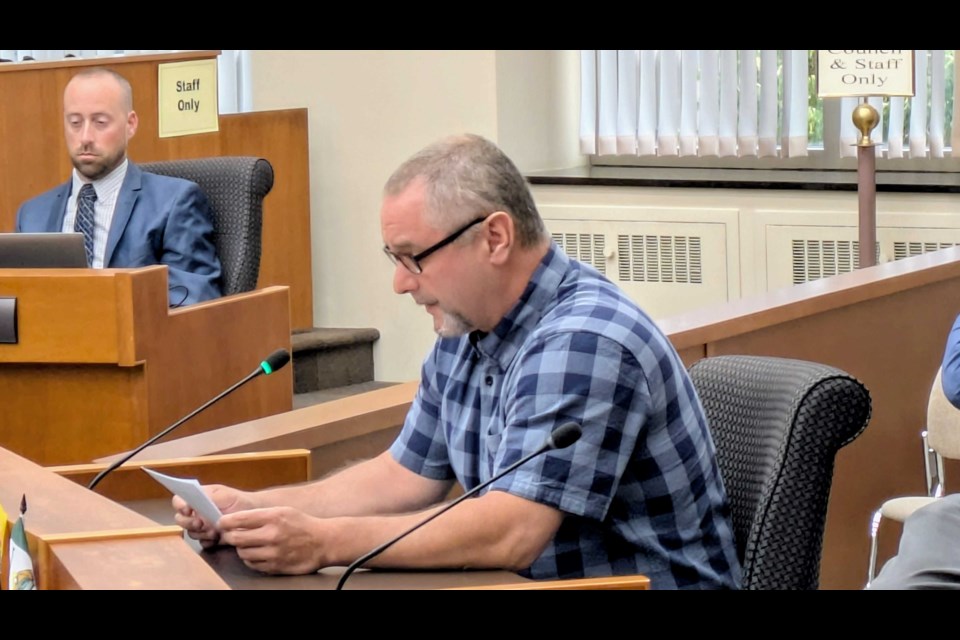THUNDER BAY – “It's not a solution,” David Kisselgoff, director of Kisselgoff Motorcycle Museum, said in his deputation regarding the temporary shelter village site at last night's committee of the whole.
On Monday, city council voted 6-5 in favour of 114 Miles Street East as the site for the temporary shelter village.
In a deputation, Kisselgoff told council that building a temporary shelter village could have a volatile economic effect on the revitalization of the downtown south core.
He has only recently opened up a small tourism business on Victoria Avenue. Speaking as a motorcycle enthusiast and business owner, Kisselgoff seeks to host motorcycle tours around the city.
“Placing a temporary homeless village on this site undermines standard-based long-term planning and downtown economic renewal,” Kisselgoff said.
He said the Miles St. location could be used for permanent high-impact development, such as affordable housing, mixed-use commercial residential buildings, or public community spaces.
He said the risk of putting the shelter village at the Miles St. location might “deter private investment, disrupting the momentum of revitalization, and signal uncertainty to developers” who are willing to rebuild the south core.
“Converting it into a temporary encampment will hurt tourism recovery. It would hurt local investment in downtown revitalization at the time we can least afford it,” Kisselgoff said.
There was no one with a lived homeless experience in the city gallery to say whether or not they would live in the shelter village once it is built, he said.
Coun. Shelby Ch'ng asked city staff what kind of consultation they had with people with lived experience of homelessness throughout this project.
“Every single person that we asked about accepting a space in the temporary village has said that they would do that," said Rilee Willianen, the city's encampment response plan lead. "Importantly, we have also engaged extensively with service providers who know that population very well. We have a good understanding of their expectations and requirements.”
“Primarily, that is location and being close to services so that people can access what they need to access, and you will see that support and confidence in the project in over 20 letters of support from your addendum package.”
The report included 23 letters of support from various organizations across the city sharing their support for the location East, including the Thunder Bay Police Service, the Thunder Bay District Health Unit, several local service providers and charities, mental health and healthcare organizations and Indigenous organizations.
Nishnawbe Aski Nation Deputy Grand Chief Anna Betty Achneepineskum said the reason NAN is supporting the site is because it’s a plan that the organization can have “in place to get the housing for the individuals that require it.”
In her deputation, she said the plan “reflects a growing national movement doing away with reactive enforcement, driven response toward proactive, rights-based and trauma-informed housing solutions. The shelter village model embraces these best practices, emphasizes low-barrier, community-integrated and culturally safe transition shelter options.”
She benefits from having Miles St. as the site is in the proximity to over 14 essential health and social services providers with existing zoning and infrastructure that have “the potential for rapid deployment.”
“The village will allow residents to access the wraparound services they need without delay. We acknowledge the concerns that have been raised about the site. The sighting of the project in the south core. These concerns are not just you. They echo longstanding fears about visibility and perceived impacts, often rooted more in stigma than in fact,” Achneepineskum said.
“International and Canadian evidence demonstrate that when these communities are planned with care and connected to services. They foster safety and stability for the residents and the broader neighbourhood.”
Agarwal pointed out that not all homeless people are illicit substance users. Some can’t afford the housing.
The shelter village being a low-barrier site, she asked Achneepineskum, would it be a good idea to mix the people with substance issues with people who do not.
“I believe that it doesn't matter where a person resides, they are at risk of being introduced to substance. With our access to the internet and contact with individuals, that is why we need to ensure that the facility proposed would have those wraparound services as well and security to ensure that those concerns are addressed,” Achneepineskum said.
